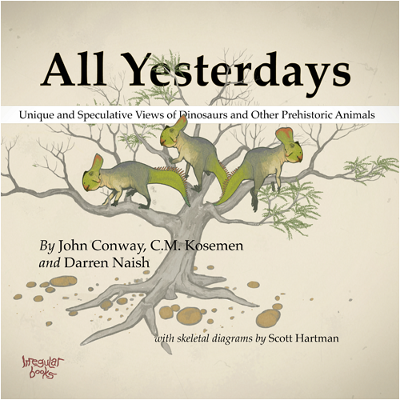Book Review: All Yesterdays
Breathing life back into lost worlds is not an easy task–how do you paint, draw, or sculpt an animal that no human has ever seen? Perhaps as a result of this, paleontological art is full of some well-worn tropes. Tyrannosaurus running at full-tilt in perfect side view. Svelte stegosaurs with not an extra ounce of body fat or fold of skin. Brachiosaurus crossing an empty, dusty plain. Many artists are doing fantastic work, but the field really needs a wake-up, shake-up, and fresh look.
All Yesterdays, by John Conway, C. M. Kosemen, and Darren Naish (along with skeletal reconstructions from Scott Hartman), sets a new standard for how we envision dinosaurs and their prehistoric cohort. These are not “shrink-wrapped” sauropods or battling beasts. They’re living animals much weirder than the bare bones can ever tell.
Thumbing my way through the 100-page softcover edition, I continually had my assumptions challenged. One second I’d be thinking “What? There’s not evidence for that!” The next I’d be thinking, “Hmm. . .it’s not in the fossil record, but it’s certainly plausible.” Both of these thoughts on the same illustration, of course! I haven’t had this much fun reading a paleontology book in years.
The authors of All Yesterdays create their magic by turning every convention of paleontological art on its head. Instead of fretting about showing only what is warranted by the fossil record and character optimization (a.k.a., the extant phylogenetic bracket), the authors show much that isn’t excluded by the fossil record. This step away from paint-by-number realism creates something truly phenomenal. Other artists, elsewhere, have made some breathtaking reconstructions of the past. But none have done it like this! Camarasaurus lolls happily in the mud. Protoceratops perch in the trees. A plesiosaur camouflages itself in the muck. These are animals happily being animals, not some 19th century taxidermy mount, or battling monsters “red in tooth and claw.” Brief and informative text accompanying each illustration highlights the knowns and unknowns, with quirky tidbits of trivia about modern animals. Even if the reconstructions are outside the norm, they are not unmoored from reality. All are scientifically rigorous in proportions, posture, environment, and known anatomy. Skeletal drawings help to underscore this point.
The illustrations are not photo-realistic, but this is a welcome relief. In many ways, they are livelier than more detailed work elsewhere. The fluffy outline of therizinosaurs feasting on leaves is only suggested by broad brush strokes, but in my mind I could fill in every extra filament and smell the cool decay of the vegetation on the forest floor. The most stylized are some of my favorites–a particularly memorable example is an amorous encounter between Stegosaurus and Camarasaurus, rendered in a black-and-orange mode reminiscent of a Greek urn.
The last half of the book jostles convention in a different way, by depicting today’s animals as if restored by paleontologists in some far-distant future. Unrecognizable rabbits and iguanas show that so much is never preserved in the fossil record! When artists stay in the shallow end of portraying only that which is absolutely known and tested, we only see the shadows of the living animals.
From the nuts-and-bolts end, the paperback edition (purchased from Lulu) was nicely bound, with an attractive glossy cover. Images were brilliantly and clearly reproduced, which is truly important for a book that relies so heavily on artwork! My only minor complaint was that a final round of copy-editing would have done some good. Many scientific names were not italicized where they should have been (almost one instance per page of text), and a few other minor typos detracted from what was otherwise a thoroughly enjoyable read. My hope is that this will get fixed in future printings. The printed book is also a tad on the expensive side ($35 through Amazon), but this is worth every penny. If you lean towards the electronic end, I would wager that the color ebook versions are just as gorgeous. But, this truly is one you’re going to want in dead-tree format. After I received this book as a Christmas gift from my wife, pretty much everyone in the household for the holidays thumbed their way through!
Congratulations to the authors on creating a truly exciting and innovative book! May it inspire others as it has inspired me.
Conway, J., C.M. Kosemen, & D. Naish. 2012. All Yesterdays: Unique and Speculative Views of Dinosaurs and Other Prehistoric Animals. Irregular Books. ISBN 978-1-291-17712-1. Softback, 100 pages. Further information at Irregular Books.
Image Credit: Protoceratops image and book cover copyright John Conway and co-authors

